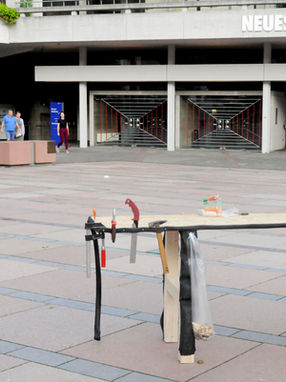UNTER:ERDE
This spatial intervention was developed in 2024 as part of a group exhibition at "Alte Schule" Gallery Adlershof, Berlin. It explores material and metaphysical qualities of earth in opposition to dualistic modes of thinking.
The work questions the separation of culture and nature, connecting garden and exhibition space. It draws interest from the street into the gallery and points from the sterile white cube into the living outdoors. A section of lawn is connected to the interior by strings, excavated, and transferred into an identically sized planter in the exhibition space, creating a hole that reveals the underlying earth. This hole serves as an observation space, raising ecological and historical questions and requiring care and interaction from visitors.
The subterranean world, hidden from sight by its very definition, has been a realm of myth and storytelling eversince – both as the abode of the dead and the source of life. Today, soil is threatened by human activities such as sealing, poisoning, and exploitation. Digging into the earth is always a form of archaeology where the past intertwines with the present, decomposing and reemerging in new forms. This project aims to highlight the complex nature of soil, create spaces for encounter, and invite contemplative observation.

In addition to the living spatial installation, several participatory formats were developed as part of the gallery's art mediation program. These activities, open to all interested inhabitants of Adlershof, focused on exploring the spatial qualities of the garden. Participants were encouraged to locate feelings and atmospheres within different areas and discover connections between the beings and objects in the space, fostering a deeper engagement with the environment.
A key collaboration involved pupils from the Sophie Brahe Schule, led by their teacher Nadine Wünsche. The students were introduced to the artistic process through a lecture that explained the project’s concepts and ideas. This provided a foundation for discussion, allowing the students to engage with the themes of space, connection, and artistic expression in a meaningful way.
Afterward, the pupils created their own spontaneous artistic interventions in the garden. By connecting different parts with string, they mapped the space and told a story through their actions. This experience not only allowed them to explore the garden creatively but also contributed to the installation’s ongoing dialogue between art, space, and community.







































